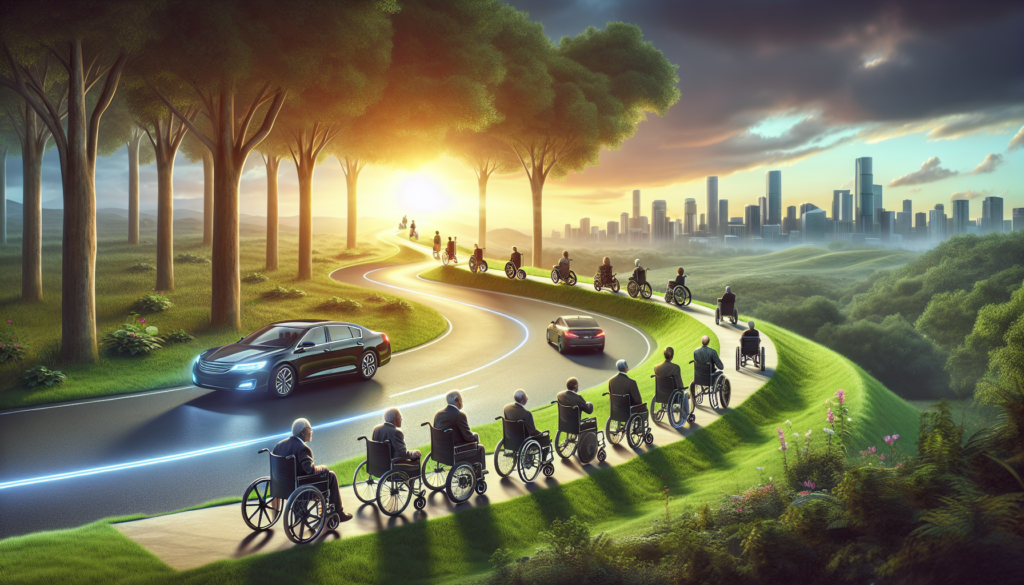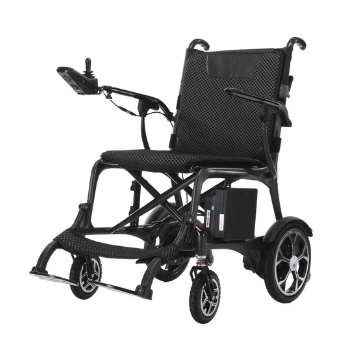The evolution of electric wheelchairs has transformed the way individuals with mobility challenges navigate their world, and with the emergence of exceptionally lightweight models, the possibilities are greater than ever. As technology advances, electric wheelchairs have become not only more efficient but also more portable, catering to the needs of active users.
Take, for example, the eDegree EW3 Lightweight Travel Electric Wheelchair, weighing only 12.5 kg while boasting a driving distance of 20-25 km and a maximum load capacity of 140 kg. Its carbon fiber frame and compact design make it an excellent choice for those seeking both convenience and durability. Let’s dive deeper into what makes these lightweight electric wheelchairs a game-changer that sets them apart from traditional models.

1. A Brief History of Electric Wheelchairs
Electric wheelchairs have come a long way since their inception in the mid-20th century. The earliest models were largely mechanical contraptions, often heavy and cumbersome, limiting mobility for users. The evolution began with the integration of electric motors and batteries, making these devices more user-friendly and accessible.
As technology progressed, newer designs became lighter and more efficient, allowing greater independence for those with mobility challenges. This shift marked a significant turning point, as electric wheelchairs evolved to accommodate various needs, leading to a surge in popularity and usage among different demographics.
In recent years, electric wheelchairs like the eDegree EW3 have showcased the incredible advancements in design and materials used. Weighing only 12.5 kg, this model is not only lightweight but also boasts features such as a carbon fiber frame that enhances durability without adding unnecessary weight. With a driving distance of 20-25 km and a maximum load capacity of 140 kg, modern electric wheelchairs have become more capable than ever.
These innovations have allowed users to experience unprecedented freedom, going beyond the limitations of traditional wheelchairs. As we delve deeper into the evolution of these remarkable devices, it becomes clear that the focus on lightweight models signifies a shift toward enhanced mobility and independence for users worldwide.
2. The Importance of Weight in Electric Wheelchair Design
The weight of an electric wheelchair plays a critical role in its functionality and usability, making it a significant factor in modern designs. Lighter models, such as the eDegree EW3 Lightweight Travel Electric Wheelchair, which weighs just 12.5kg, are increasingly popular due to their ease of transportation and maneuverability.
A lightweight design not only allows users to transport their wheelchairs more easily in vehicles or public transport but also enables better handling in tight spaces, enhancing the overall user experience. The combination of a carbon fiber frame with a compact design means that these wheelchairs can deliver impressive durability without compromising on weight, making them highly appealing to active users who require both functionality and portability.
In addition to transportability, the weight of an electric wheelchair impacts energy efficiency and driving range. For instance, the eDegree EW3 offers a driving distance of 20-25km, which is notable for its class. This can be largely attributed to the reduction in weight, allowing for less energy consumption during operation.
A maximum load capacity of 140kg also means that these lightweight models cater to a broad range of users, providing them with autonomy without the burden of excessive weight. As technology advances, the focus on creating lighter electric wheelchairs will continue to drive innovation, ensuring that users can enjoy independence and mobility in their daily lives.

3. Key Features of Lightweight Electric Wheelchairs
Lightweight electric wheelchairs have transformed mobility solutions for many users, combining functionality with user-friendly designs. One notable example is the eDegree EW3 Lightweight Travel Electric Wheelchair, which weighs only 12.5 kg. This impressive weight allows for easy transportation, making it ideal for individuals who need to travel frequently.
Another important feature is its robust driving distance of 20-25 km on a single charge, providing users with the freedom to navigate their surroundings without constant recharging. Additionally, the wheelchair boasts a maximum load capacity of 140 kg, ensuring that it can support a variety of body types while maintaining stability and comfort. Material and design play a crucial role in the effectiveness of lightweight electric wheelchairs.
The eDegree EW3 utilizes a carbon fiber frame, which not only helps in reducing the overall weight but also enhances durability and strength. Its assisted handling compact design further sets it apart, catering specifically to those who desire an intuitive and hassle-free experience.
A seat width and length of 51 cm x 51 cm ensures that users feel comfortable and secure. Priced at $2899, the eDegree EW3 embodies how modern engineering meets user needs in the realm of electric wheelchairs, demonstrating that lightweight models can deliver both convenience and innovation.
4. Comparing Comfort: Traditional vs Electric Wheelchairs
When comparing the comfort between traditional and electric wheelchairs, users often find that electric models provide enhanced ergonomics and ease of use. Traditional wheelchairs typically require the user to rely on manual propulsion or assistance, which can lead to fatigue and discomfort during extended use. In contrast, electric wheelchairs, like the eDegree EW3 Lightweight Travel Electric Wheelchair, offer a comfortable seating arrangement, allowing for a more relaxed experience.
With a seat width and length of 51cm x 51cm, it accommodates users snugly, while the lightweight construction of 12.5kg ensures effortless maneuverability. These features can greatly reduce the strain on the body, allowing users to engage in daily activities with greater freedom and less discomfort. Moreover, electric wheelchairs are equipped with advanced designs that enhance the overall user experience.
The eDegree EW3‘s assisted handling compact design ensures not only smooth navigation but also increased comfort on uneven surfaces. Traditional models may lack these supportive features, leading to a more jarring experience for the user.
Electric wheelchairs typically come with adjustable seating options and positioning controls that can be customized to fit individual needs, making them superior for long periods of use. As electric wheelchairs continue to evolve, the focus on comfort stands out as a primary factor, further distinguishing them from their traditional counterparts.
5. Performance Metrics: Driving Distance and Load Capacity
When evaluating the performance of electric wheelchairs, two critical metrics come to the forefront: driving distance and load capacity. The eDegree EW3 Lightweight Travel Electric Wheelchair exemplifies excellence in these areas, boasting a driving distance of 20-25 kilometers on a single charge. This range is particularly impressive for a lightweight model, making it a viable option for those who need to navigate through various environments without frequent charging breaks.
With a max load capacity of 140 kilograms, it caters to a broad spectrum of users, ensuring that individuals of different weights can benefit from its robust design and functionality. The eDegree EW3’s utilization of a carbon fiber frame contributes significantly to its lightweight nature, weighing in at just 12.5kg.
This feature not only enhances its portability but also complements its assisted handling compact design, making it easier to maneuver in tight spaces. As electric wheelchairs continue to evolve, performance metrics such as driving distance and load capacity have become pivotal in distinguishing the most efficient models. The eDegree EW3 stands out as a testament to how advancements in technology can create practical, user-friendly solutions for those dependent on mobility aids.
7. Future Trends in Electric Wheelchair Technology
The future of electric wheelchair technology is poised for remarkable advancements, reflecting the growing demand for lightweight, efficient, and user-friendly models. As demonstrated by the eDegree EW3 Lightweight Travel Electric Wheelchair, which weighs just 12.5 kg, innovative materials such as carbon fiber are becoming increasingly prevalent.
These materials not only enhance mobility but also provide durability and support for users, making them a popular choice among manufacturers. The EW3 model, with a driving distance of 20-25 km and a maximum load capacity of 140 kg, exemplifies how lightweight design can coexist with functionality, providing independence to those with mobility challenges.
As technology evolves, expect a surge in features like compact folding mechanisms, further reducing their weight and improving portability, ultimately encouraging a more active lifestyle for users. Beyond lightweight construction, we can anticipate advancements in smart technology integration within electric wheelchairs.
Features like app connectivity for personalized adjustments, real-time health monitoring, and enhanced navigation systems will likely become common in future models. These innovations will not only improve user interaction but also ensure heightened safety and reliability. The evolution of e- wheelchairs, especially in terms of weight and functionality, underscores a commitment to enhancing the quality of life for users, thus paving the way for a more inclusive and technologically advanced future in personal mobility solutions.
Final Thoughts on Electric Wheelchair Innovation
As we’ve explored throughout this blog, the evolution of e-wheelchairs has undoubtedly brought about remarkable advancements, especially in terms of weight and mobility. The eDegree EW3 Lightweight Travel Electric Wheelchair exemplifies this innovation with its incredible features.
Weighing only 12.5 kg yet capable of accommodating loads up to 140 kg, this e-wheelchair provides an impressive driving distance of 20-25 km, proving that lightweight designs can still pack a punch in performance. Its carbon fiber frame and compact assisted handling design further enhance its user-friendliness, making it ideal for both travelers and everyday users alike.
The shift from traditional to e-wheelchairs signifies not just a change in technology, but also in lifestyle enhancement for users seeking mobility solutions. With products like the eDegree EW3 at a competitive price of $2899, it becomes clear that the future of e-wheelchairs is not only lighter and more efficient but also accessible to a wider audience. Whether you’re considering an upgrade or making the switch from a traditional model, investing in a lightweight e-wheelchair can significantly improve your overall mobility experience and quality of life.
This post is really informative and sheds some light on the key developments in electric wheelchair technology. I appreciate the discussion on future trends, hoping these advancements would be accessible to more people.
Hi Sarah Lim, thank you for your kind words about our blog post on electric wheelchair technology! We’re glad to hear that you found the information informative and helpful. At Eko Life, we believe that e-wheelchairs should be accessible to everyone, and we’re committed to making them more affordable and user-friendly. If you have any questions or would like to learn more about our e-wheelchairs, please don’t hesitate to reach out to us at [email protected] or +65 6589 8877. We’re always here to help!
The information presented here about e-wheelchairs being more efficient and portable is spot on. It’s amazing to see how technology has improved their overall design.
Hi Akmal, thank you for sharing your appreciation about the advancements in e-wheelchair technology. We couldn’t agree more! At Eko Life, we strive to bring the latest and most efficient e-wheelchairs to our customers, prioritizing comfort, energy efficiency, and portability. If you have any specific questions or need assistance with finding the right e-wheelchair for your needs, please don’t hesitate to reach out to us via [email protected] or +65 6589 8877. We’re here to help!
While this post highlights exciting developments, I worry that these advancements might be unaffordable for many. I wish there were more discussions about accessibility and affordability.
We completely understand your concern, Faith. At Eko Life, we believe that accessibility and affordability should go hand-in-hand with innovation. We’re always on the lookout for affordable e-wheelchair options that cater to a wide range of users. Luckily, we have some budget-friendly e-wheelchairs available in Singapore, Malaysia, and soon in Indonesia. If you’re interested in learning more, please feel free to reach us via email at [email protected] or call us at +65 6589 8877. We’d be more than happy to guide you in finding the perfect e-wheelchair that suits your needs and budget.